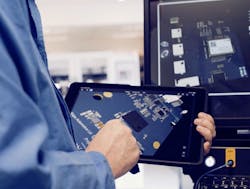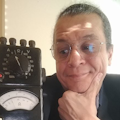Altium's Leigh Gawne on Using a Collaborative Design Environment
Even before COVID-19 disrupted how we work, online collaborative tools were already being used by the more forward-thinking early adopters. Now that working from home has become the norm, and the need to empower employees that may be scattered across the globe, online collaborative tools are needed more than ever. In the electronic design space, face-to-face meetings must be supplemented with the ability to work on detailed designs as a real team.
The ability to empower collaboration at every point of the design process is a modern business necessity. Solutions like Altium 365, the eponymous company’s cloud-based platform for PCB design and realization, enabled Altium’s customers to function through the worst of this situation. Addressing the distributed workplace will be a significant aspect of the market for the foreseeable future, and a natural migration for the modern design engineer.
We met with Leigh Gawne, Chief Software Architect at Altium, who was the architect behind the Altium 365 cloud platform, and leading its design and implementation. We talked to him about collaborative design and group design, and framed it within the current pandemic environment.
EE: Isn't collaborative design an issue that existed before the pandemic?
Leigh Gawne: Absolutely, absolutely. Just as we've just been talking here, we collaborate every day in everything, you know. To get anything done involves us kind of collaborating, so this notion that it's maybe some kind of like New-Age thing, or you know buzzword or anything like that to me is just completely not the case. We do it all the time. The question is how well we do it, and how effectively we are doing it. So you're absolutely right.
For me, this isn't something that's just a COVID-19 thing, but actually the kind of implications on wider society. Our ability to collaborate has been restricted to using mediums that perhaps were secondary before. To give you an example, a few weeks ago, I probably would have just jumped in my car and driven to a customer site, and be sitting in the conference room having a coffee with them. Discussing something today is not possible, right, you know, everything has to be done remotely.
EE: Talking about collaboration, as we were saying that is, it was an earlier necessity, especially when you're talking about designing something complicated over multiple regions. Currently there are constants and variables in collaboration, and the pandemic environment is exposing the issues.
Leigh Gawne: It's really forcing you to look at necessity, right, whether or not you really have to actually do something. Design is a really good example, you know, today it's not really one person that's just sitting down doing everything from, idea creation through actually producing that thing you've got in your hand. It's much, much more complex, in than that you've got many people that need to come together with their own specialty. They need to kind of add their value at that point in that kind of value chain, for you to be able to kind of realize something at the end of the day. That's really the kind of key thing.
EE: Now to use an example from a recent press release of yours on an open-source ventilator project. Now that highlights both aspects, the collaborative aspects of the pandemic, and the collaborative efforts to address issues.
Leigh Gawne: Yes, I think that was a really powerful and timely example, you know, Altium 365 as a platform is something that's actually only really been kind of in the public domain for a relatively short time now. Access to that platform has allowed people to work in a way that really wouldn't have been possible prior to that. At the end of the day the tools are facilitating the ability for people to come together and work together.
EE: Then let's let's talk a little bit of nuts and bolts without naming names. There are other collaborative solutions out there and that have been out there. How would you contrast what Altium has done, compared to those other efforts?
Leigh Gawne: I think there's one key thing here, is that this kind of solution, as it were, is what we kind of call “CAD aware”, where it's got CAD intelligence. Now what do we kind of mean by that? Well, as you know, CAD is an extremely visual thing, you know, if I'm sitting down in designing something, whether it's schematic capture, whether it's layout, whatever aspect, there's a very strong kind of visual part of that.
And I think up to this point that visual expression has absolutely been lost, with most of those other solutions. So as soon as you try to take care of the desktop, we kind of break down and we lose that kind of visual depth. What we end up with is static screenshots and these kinds of things. It's nothing that can be fully interactive with. I think our human solution is very much one that makes that possible.
So now if you look at the design and what was possible on the desktop, it's actually possible in the browser. So you can go to your browser, you can interact with that design. It's not just a static screenshot. For instance, a schematic or a layout, but I can interact with things, I can, you know, inspect components. I can highlight nets and tracks. I can cross prob. I can get that whole kind of like 3D rendering of that board in my browser, I can pan around. I can inspect it. So I think this kind of bringing, fusing together, CAD with Cloud is really the kind of proposition there that has not been there before.
EE: OK, let’s say I have an idea. I'm a skateboard guy, and I know everything about the mechanical engineering side of the house. And I want to make a powered skateboard. And I have a buddy of mine, he lives in Silicon Valley, and he can do all of the electronic side of the house. And on the other side of town is my buddy who does the artwork. Now I know I'm going to be collaborating remotely with the guy across the country. But what would incentivize me to stay at home and not just go across town and lean over his shoulder?
Leigh Gawne: Well, fundamentally, I think. Let's take the example that you just brought the two guys have the electrical guy, you know, your body over there and you're the mechanical guy. Now historically, for you to work together would have involved scribbling down some sketches, you know, maybe some ideation on boards and things like that. And that's how you might have come through to it.
But then when you finally start actually having to work together, you've got some mechanical constraints going on there and your buddy is starting on the PCB side of things. He's got his design. He's kind of trying to bring everything together. You're now trying to make all of that kind of fit. I mean, it's got various requirements that it's got to hit. It's going to fit within some kind of constrained space, for instance, there's also going to be some visual effects, and some other requirements from a performance perspective, and so on and so forth.
Now, prior to Altium 365, the way that you would have done this would have been a bit painful. You would have had to figure out a common file format, by which you can exchange information. So you might be trying to export something in one format, but then have to try and maybe import this, and bring that in, and make that fit, and do the adjustments that you do. And that's not normally a one-time thing. I mean, your design is going to continue to evolve. The key thing then is that this is going to have to happen fairly regularly. So it's not just the case of doing it once, it's a case of doing it many, many times. And it's that particular thing, that rhythm that you have, that ends up with you getting in trouble all the time because you end up getting out of sync.
Inevitably, it's hard to kind of formalize the exchange of this information control in an effective way. With Altium 365 today, all of that is effectively taken care of. For you and your buddy, if he's working with someone in another country, you can just connect his tool directly through your 365 natively. So as soon as you're ready with, you know, an update to your design, you can push that over to him and vice versa. During this pushing and pulling, you can always see what's actually changed. You can choose to accept or reject those kinds of changes, and so on and so forth.
Even the mechanical engineer can actually start to do things like define board outlines and connected positions, we call them cantilever component placement, this kind of stuff that was just not possible really in the past. This way, if you touch anything, you do that in an effective way that the electrical engineer will be able to bring in and make use of it. So I think it's really that kind of seamless connectivity, that ability to have this kind of fluid design into change as you go through that process on a regular basis. That's really a powerful kind of proposition.
EE: Okay then, what would you like to leave our readers with as a final thought?
Leigh Gawne: I think one thing I want to say is that, you know, this is really just the beginning. If we look at how things have been prior to Altium 365, it was difficult for people in the value chain to really come together in an effective way. And we're certainly not saying that as of today, we have solved every single one of these problems. But we have made the first big steps towards enabling a solution that will make that happen. So we call this kind of digital continuity.
Bringing digital continuity between design manufacturing and supply-chain domains in a way that all of those stakeholders can kind of stay on the same page and stay in sync is really the kind of thing that we're aiming to do here. So I think one of the things I do want to really point out is, this is a journey that we're on, but this is just the beginning. So going forward, you'll see more and more capabilities coming in that really, really will make a big difference to the way that you design and realize electronics.
About the Author
Alix Paultre
Editor-at-Large, Electronic Design
An Army veteran, Alix Paultre was a signals intelligence soldier on the East/West German border in the early ‘80s, and eventually wound up helping launch and run a publication on consumer electronics for the US military stationed in Europe. Alix first began in this industry in 1998 at Electronic Products magazine, and since then has worked for a variety of publications in the embedded electronic engineering space. Alix currently lives in Wiesbaden, Germany.
Also check out his YouTube watch-collecting channel, Talking Timepieces.


